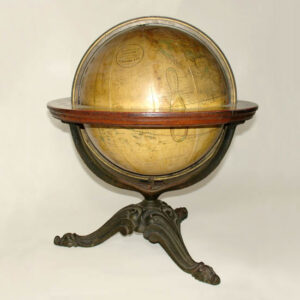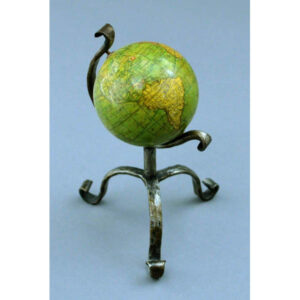Description
Adding cutout collaged elements to engravings and lithographs was a popular pastime in Victorian England. The art of collage is related to the French art of decoupage — the use of cut outs from engravings applied to decorative arts, often varnished. Decoupage was popularized in the late 18th century as a pastime and art exercise for youths and ladies. This trend developed further in Victorian England:
[H]andcoloring and intricate cutting out gave way to the more sentimental, florid collage-style of [decoupage]. This coincided with the introduction of Valentine cards, decorative and embossed papers and braids to embellish surfaces such as screens, lamp bases, linen boxes and much more. Many a Victorian nanny taught her young charges to beautify objects by applying decorative paper pieces to them (Decoupage Artists Worldwide).
Collage was also used directly on other prints and works on paper. Genre prints of famous actors in costumes were frequent subjects for Victorian collage, as were images of medieval knights and jousters. Another common practice was to enhance fashion prints or natural history prints, particularly of monkeys. Indeed similar collages based on Buffon’s monkey engravings are known. Among the materials used for collage were cutouts from other prints, fancy paper and shiny tinsel paper. Some artists also used fabrics, sewing notions, and sequins. Tinsel work was a special art as applied to a reverse painting on glass, but tinsel cutouts — sometimes with the addition of hand-incised details — were also was popularly applied as collage to prints:
Tinsel pictures are also allied with the 18th-century English art of decorating prints with textiles and colored paper. This was an art that later reflected the English addiction to the theater, when English people glorified prints of theatrical luminaries — threatening villains and romantic heroes and heroines — with little pieces of silver and gilt paper, paper stars and spangles, and little strips of red and blue paper. These English prints were also sold already decorated. Today they are coveted when framed in curly maple. […] Like so many earlier ”ladylike arts” —needlework and painting on velvet — American tinsel pictures were made in boarding schools (Rivera).
The Victoria and Albert Museum in London has a large collection of tinsel prints and notes, “They were popular during the first half of the 19th century and were considered an adult, rather than a child’s hobby. By the 1830s it was possible to buy the tinsel, leather and feather ornaments to go with each image.”
Jean-Baptiste Audebert, a painter by training, was born in Rochefort, France. After receiving a commission to help with the preparation of the plates for Guillaume Antoine Olivier’s Entomologie (Paris: 1789-1808), he also began producing natural history prints. Histoire Naturelle des Singes was published in 10 parts between 1797 and 1800 and sold by subscription, the only publication of Audebert’s work to be completed during his life-time. Other natural history print collections by Audebert include Oiseaux Dorés.
According to scholar S. Peter Dance:
The tradition embodied in the brilliant dynasty of miniaturists… gave zoological art in France an overall uniformity and distinction that was not equaled elsewhere. The illustrations in books such as the Histoire Naturelle des Singes et des Makis by J.B. Audebert had few serious rivals outside France in the early years of the nineteenth century.
Condition: Generally very good with the usual overall light toning, wear, soft creases. Collage costume elements added with glue; collage musical instruments applied with slits in original print. Page margins trimmed with partial loss of credit line in bottom margin. Frames with usual wear (please inquire for picture of frames).
References:
“A Bit of History.” Decoupage Artists Worldwide. 2013. http://www.decoupage.org/a-bit-of-history/ (5 June 2014).
“Audebert.” The 1911 Encyclopedia. http://52.1911encyclopedia.org/A/AU/AUDE.htm (23 January 2004).
Brunet, J-Ch. Manuel du Libraire et de L’amateur de Livres. 5th ed. Paris: Firmin Didot Frères et cie, 1860-65. 550.
Dance, S. Peter. The Art of Natural Animal History Illustrators and Their Work. New York: Overlook Press, 1990.
“Karl von Linné (Carolus Linnaeus) and His Names for Primates.” http://members.aol.com/darwinpage/zoo/linnaeus.htm (23 January 2004).
Nissen, Claus. Die Zoologische Buchillustration: ihre Bibliographie und Geschichte. Stuttgart: 1969-78. 156.
Rivera, Betty. “Tinsel pictures: a forgotten folk art shimmers anew.” Christian Science Monitor. 8 December 1983. Online at Christian Science Monitor: http://www.csmonitor.com/1983/1208/120813.html (5 June 2014).
“Tinsel Print.” Victoria and Albert Museum. 2017. http://collections.vam.ac.uk/item/O1156046/tinsel-print-j-redington/ (23 August 2017).
Wood, Casey A. (ed.) An Introduction to the Literature of Vertebrate Zoology Based Chiefly on the Titles in the Blacker Library of Zoology, the Emma Shearer Wood Library of Ornithology, the Bibliotheca Osleriana, and Other Libraries of McGill University, Montreal. London: Humphry Milford, Oxford University Press, 1931. p. 206.







